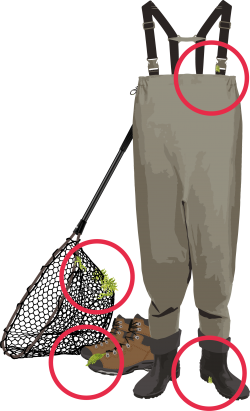Help stop the spread of invasive plants and animals!
Invasive aquatic plants and animals harm the environment and block waterways. They can be small and hard to spot so are easily spread on damp equipment and clothing. Read more on plants and animals to look out for. Once established they become extremely difficult and expensive to eradicate, which is why it is so important to prevent their spread in the first place.
When you're working or volunteering in the field, it's important to keep your kit free of invasive plants and animals in order to protect the environment.
Basic biosecurity advice for anyone working in the field
- Plan visits so that the most risky visit is the last one of the day.
- Arrive at the site with clean footwear and vehicle.
- Ensure footwear is clean (visually from soil and debris) before leaving the site.
- Ensure your vehicle is kept clean - in particular remove any accumulated mud before leaving the site.
- Make use of facilities provided on the site to clean footwear/equipment.
- Keep access to a minimum. If practical do not take vehicles onto premises, keep to established tracks and park vehicles on hard standing.
- Where possible avoid areas of livestock and areas with known plant disease.
- Check whether your organisation has any other guidance.
Whenever you leave the water, remember to Check Clean Dry

Check
Check your gear after leaving the water for mud, aquatic animals or plant material. Remove anything you find and leave it at the site.

Clean
Clean everything thoroughly as soon as you can, paying attention to nets, waders, and areas that are damp and hard to access. Use hot water if possible.

Dry
Dry everything for as long as possible before using elsewhere as some invasive plants and animals can survive for two weeks in damp conditions.
Free online training
Learn more with our free online biosecurity training for anyone working in the field. Other modules including identification of common non-native species are also available.
Going abroad?
It's even more important to Check Clean Dry if you're taking your kit abroad to make sure you don't bring any plants or animals back with you. Make sure everything is clean and has been dried thoroughly before you use it again at home.
Check Clean Dry materials
Download free materials below to remind yourself and other water users to Check Clean Dry. Contact us to order free hard copies.
Signs / posters
Other materials
Find a full list of Check Clean Dry materials
Other ways to help stop the spread
If you would like to get more involved in protecting your watercourses from invasive non-native species you could:
- Join a Local Action Group working on invasive species management, or get involved in controlling floating pennywort.
- Look out for and record invasive non-native species online via iRecord or through a smartphone app. View free ID guides for over 60 species.
- Take free online training in identification, recording and biosecurity.
Thank you for helping to protect the environment.

